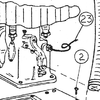Ed Haywood
En-Route
I bought a snubber from American Champion to dampen the pulses to the mechanical fuel pressure gauge in my Decathlon. The instructions are lousy, the part is not shown on my parts manual, and I haven't been able to get the factory on the phone.
Should the snubber be installed on the engine end of the line, or the gauge end? Gauge end would be easier, but I wonder if the snubber would provide some mitigation for a line break if installed at the engine side.



Does the orientation make a difference? Eg male end towards flow source or away?

Should the snubber be installed on the engine end of the line, or the gauge end? Gauge end would be easier, but I wonder if the snubber would provide some mitigation for a line break if installed at the engine side.



Does the orientation make a difference? Eg male end towards flow source or away?











